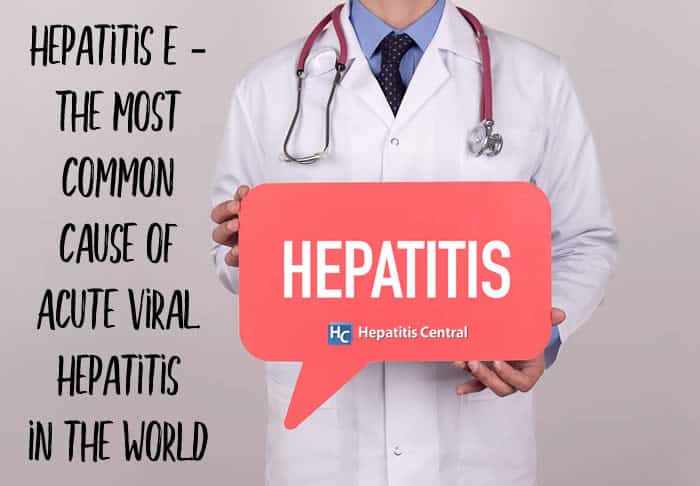Hepatitis E – The Most Common Cause of Acute Viral Hepatitis in the World


When it comes to liver disease there seems to be no shortage of possibilities. Joining the ranks of hepatitis A, B, C and D, hepatitis E (HEV) is no slouch when rounding out the alphabet virus squad. HEV is found across the globe, caused only by infection with the hepatitis E virus, and has been recognized as a distinctly human disease since 1980.
Even more impressively, hepatitis E exists as the most common cause of acute viral hepatitis in the world and, according to the World Health Organization (WHO), there are an estimated 20 million HEV infections, 3.4 million symptomatic cases, and 70,000 global deaths per year.
Although the symptoms may be similar, the genetics of each hepatitis virus are unique, with differing modes of transmission, infection courses, and treatments options per disease. However, most experts agree that infection with one or more types of hepatitis viruses simultaneously carries a worse prognosis. Especially when laden with chronic hepatitis C, infection with multiple hepatitis virus’ typically signals compounding potential for liver damage.
HEV Transmission
Similar to how hepatitis A is contracted, HEV is transmitted via the fecal-oral route. Primarily a waterborne disease, most hepatitis E outbreaks have been associated with the consumption of contaminated water or food supplies.
Drinking water contaminated with fecal matter or ingestion of raw or uncooked pork or shellfish have been commonly implicated in cases of HEV in endemic areas. As an extension of the fecal-oral transmission route, HEV could potentially be transmitted when infected animals and livestock meet poor sanitation practices.
However, unlike hepatitis B which is 50 to 100 times easier to transmit sexually than HIV, there is no evidence that hepatitis E is transmitted through sexual contact, exposure to needles, or blood transfusions.
Where Is Hepatitis E?
The highest rates of Hepatitis E infection occur in regions where low standards of sanitation promote the transmission of the virus. That being said, poor sanitation isn’t always the culprit, and the mechanism by which HEV rears its head varies by region.
Most European countries, China, Japan and North America find Hepatitis E infection resulting from under-cooked pork. In other regions such as Mexico, India and Africa, hepatitis E is most commonly spread through water sources contaminated with fecal matter. In addition to the natives, travelers visiting the above locations are susceptible to this infection.
Pay attention to the seasons when planning your travel as outbreaks and epidemics are more likely to follow water supplies becoming contaminated with sewage after monsoons or flooding. Infected individuals in the United States have usually returned from traveling to an area where the virus is more common. Although primarily affecting regions with poor sanitation, sporadic cases of hepatitis E have been reported elsewhere, and serological surveys suggest a global distribution of strains of HEV.
Symptoms and Disease Course
As a viral infection targeting the liver, symptoms of Hepatitis E are eerily reminiscent of other strains of hepatitis:
- Jaundicing of the eyes or skin
- Fatigue or low energy
- Abdominal pain or discomfort
- Loss of appetite, nausea or vomiting
- Dark urine
- Fever
- Body aches
In general, hepatitis E is a self-limiting viral infection. As such, HEV is typically limited to an acute course, meaning it’ll clear up naturally with any intervention. Most people don’t need to be hospitalized and most cases of HEV are still believed to go undiagnosed.
The highest cause for concern is if HEV isn’t the only condition someone is dealing with. It’s often when co-infections occur that HEV can become truly serious.
If you suspect you or someone you know has been exposed to HEV, you should consult your doctor immediately and be aware of the following facts:
- Once exposed to hepatitis E, the infection takes hold within one to two months.
- Infected persons are presumed contagious for up to two weeks after symptoms appear.
- Unlike hepatitis B and C, there are no known cases of chronic hepatitis E reported.
- Symptomatic HEV infection is most common in young adults aged 15 to 40 years.
- Although HEV infection is frequent in children, it is mostly asymptomatic and goes undiagnosed.
Treatment and Prevention of Hepatitis E
At present, no commercially available vaccines exist for the prevention of hepatitis E in the United States. However, a phase 1 clinical trial was just approved by the FDA and launched in May of 2019 for a promising HEV vaccine called Hecolin under patent HEV-239. Hecolin has been commercially available in China since 2012.
The only available treatment once infected is rest and increased fluid intake – similar to how you would recuperate from the flu or common cold. And, unfortunately, since hepatitis E is a viral disease, antibiotics are of no value in the treatment of this infection. Unlike hepatitis A and B, there is no immune globulin to protect or recover from HEV.
Since no specific therapy is available to alter the course of acute hepatitis E infection in the U.S., prevention is the most effective approach against the disease.
As almost all HEV infections are spread by the fecal-oral route, good personal hygiene, high quality standards for public water consumption, and proper disposal of sanitary waste can prevent most Hepatitis E exposure.
For travelers headed to highly endemic areas, proper food, hygiene, and sanitary precautions are recommended.
These include:
- Not drinking water and/or ice of unknown purity.
- Not eating uncooked shellfish, pork, or even fruits and vegetables not peeled and prepared by you.
Of Most Concern
The way hepatitis E rears its head region to region varies. European countries, China, Japan and North America tend to see hepatitis E infection resulting from undercooked pork. Other regions such as Mexico, India and Africa see heptitis E more often spread through water sources contaminated with fecal matter.
While hepatitis E infection does not pose a major health threat, it can be dangerous for pregnant women or those already infected with another virus, hepatic or otherwise.
- Pregnancy – Although HEV infection is typically mild, 1-2% of those infected develop a sudden and severe form of liver disease known as fulminant hepatitis and primarily occurs simultaneously with a pregnancy. Fulminant hepatitis is associated with a mortality rate of 20% among pregnant women in their third trimester.
- Co-Infection – While past studies may have alluded to a relationship between HIV and HEV infection, a recent cohort/case-control study published in HIV Medicine discredited that theory. Researchers found the connection flimsy at best, with their risk factor analysis suggesting “that HEV is unlikely to be transmitted sexually, but more likely through consumption of under-cooked pork products.”
Conclusion
Nobody wishes to fall ill and be bedridden with hepatitis E. However, those most at risk are confined to special populations of pregnant women and those already infected with a hepatitis virus.
Until a vaccine is commercially available to prevent HEV, any members of these special populations should pay keen attention to food hygiene, especially if traveling to regions where hepatitis E is a problem.
- New Hepatitis E Virus Flares Up in Korea. (2007, June 21). Retrieved August 19, 2019, from http://english.chosun.com/site/data/html_dir/2007/06/21/2007062161017.html Copyright © Chosunilbo & Chosun.com ©
- Hepatitis E Information | Division of Viral Hepatitis | CDC. (n.d.). Retrieved August 19, 2019, from https://www.cdc.gov/hepatitis/hev/index.htm Published Online by The U.S. Department of Health & Human Services
- Staff, S. X. (2019, July 11). Scientists map high-risk areas for hepatitis E. Retrieved August 19, 2019, from https://medicalxpress.com/news/2019-07-scientists-high-risk-areas-hepatitis.html
- Keane, F., Gompels, M., Bendall, R., Drayton, R., Jennings, L., Black, J., . . . Dalton, H. (2012, January). Hepatitis E virus coinfection in patients with HIV infection. Retrieved August 19, 2019, from https://www.ncbi.nlm.nih.gov/pubmed/21819531
- Hepatitis E Hecolin (HEV-239) Vaccine Clinical Study Launched in the USA. (n.d.). Retrieved August 19, 2019, from https://www.precisionvaccinations.com/innovax-hecolin-hev-239-only-hepatitis-e-virus-vaccine-available
- Remy, P. (2019, May 30). Hepatitis E. Retrieved August 19, 2019, from https://emedicine.medscape.com/article/178140-overview
- Hepatitis E. (2019, July 8). Retrieved August 19, 2019, from https://www.who.int/news-room/fact-sheets/detail/hepatitis-e Copyright 2019 WHO








1 Comment
i feel bad for the people who have this disease.